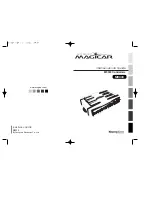
3931203/02/07/C
7
Doepke
Operating Instructions
Dupline Smoke and Fire Detector DRD 2
11. General Information
The optical smoke detector DRD 2 is a component of the Dupline building management
system and allows an early detection of smouldering fires as well as flaming fires that de-
velop smoke. It operates on the proven light scatter principle. Inside the sensing cham-
ber a light source and a light sensor are arranged so that light normally does not fall on
the sensor. It is only when airborne particles enter the chamber that light is scattered onto
the sensor (Tyndall effect) to produce the electrical signal. This design means that no ra-
dioactive source is required.
The DRD 2 only needs the connection to the Dupline conductors. The smoke alarm as
well as the status signal, which indicates the correct connection between the smoke de-
tector and the in-built Dupline circuit board, are transmitted via the Dupline bus. Besides
the alarm, the LED in the housing of the DRD 2 shows also the state of function of the de-
vice.
12. Coding
At the 4-pole flat pack connector D of the PCB A, which is accessible after screwing off
the base, it is possible to assign any addresses between A1 and P8 to each channel, us-
ing the hand encoder DHK 1 (see chapter 20 “Anschlussschema / Connection Diagram”
on page 11). The channel allocation is as follows:
Channels, which are not used, should not be encoded. The encoding of the DRD 2 can
be done without any connection to the Dupline bus and is carried out using the flat pack
encoding cable DKP 2. The correct polarity of the plug has to be observed (see connec-
tion diagram). The encoding remains permanently but can be overwritten at any time.
13. Mounting
13.1. Connection
Only an authorized expert is allowed to carry out the installation. Before mounting the
base of the DRD 2 has to be removed from the housing by screwing it anticlockwise. The
connection to the Dupline bus is done at the screw terminals B on the vertically mounted
PCB A (Dupline signal con at the red marked screw terminal, see chapter
20 “Anschlussschema / Connection Diagram” on page 11). For accessing the PCB, it
Channel
Description
Channel
Description
1
Alarm signal
a
a. Active on occurance of an alarm
5
Not assigned
2
Status signal
b
b. Active when bus signal lines are connected and smoke detector is working: every 50s this
channel is active for 1 cycle.
6
Not assigned
3
Not assigned
7
Not assigned
4
Not assigned
8
Not assigned






























